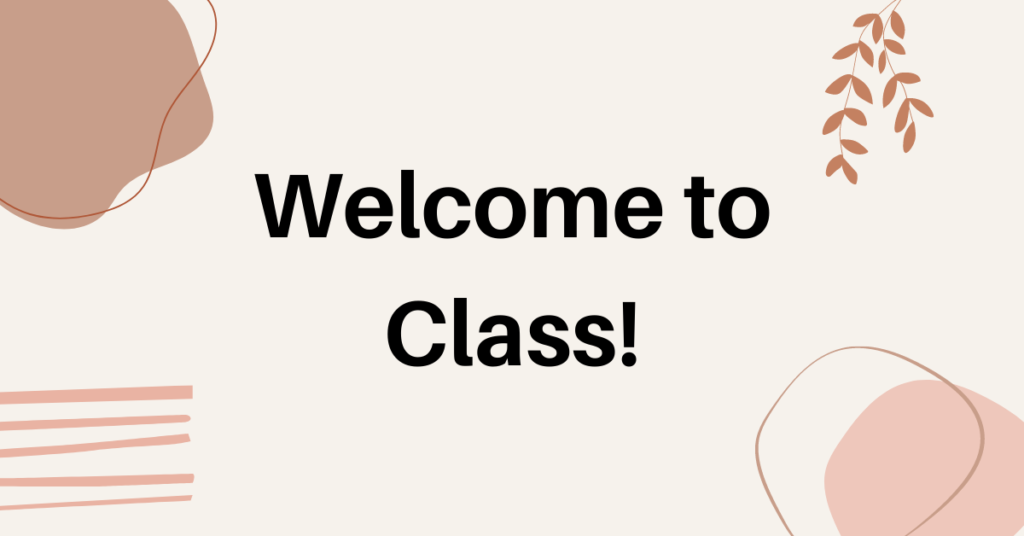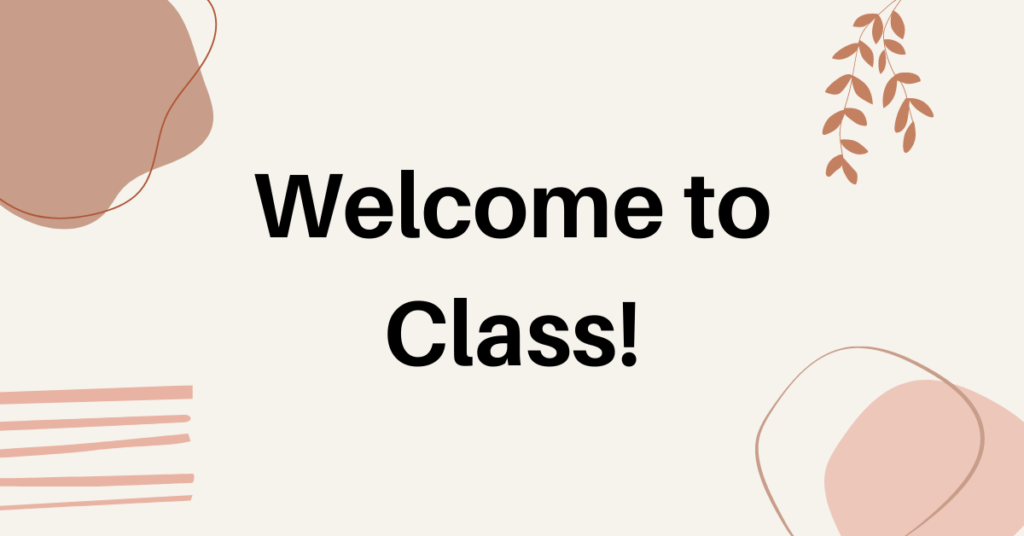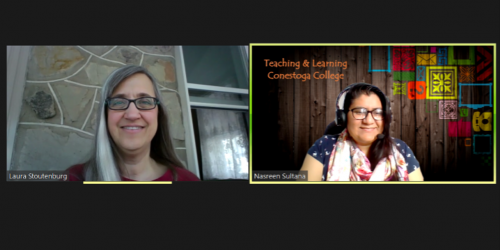
What To Do in the First Weeks of Class
This teaching tip provides a checklist of what you can do in the first week or two of class to share important information and create an atmosphere that supports learning. This tip shares ideas for
- Creating a positive learning environment
- Explaining key course information
- Setting expectations for behaviour
- Encouraging a focus on learning
- Sharing expectations for technology use
Use these tips in for courses in delivered in any mode of delivery.
1. Positive Learning Environment
A positive setting for learning is one that that gives students a sense of security and inclusion. Here are simple ways that you can provide students with a setting conducive to their learning at the beginning of your classes.
A warm welcome: Students who feel welcome and safe in their classes will be one crucial step closer to the kind of engagement needed for successful learning (Cox & Strange, 2016, p. 216).
Clear expectations for learning: Conestoga’s student body is diverse, and classroom expectations must be clarified to ensure that everyone understands them, regardless of their previous experience.
Mutual respect: Respect is the most basic ingredient to make effective interaction between teacher and learners possible. The duty to ensure mutual respect for all members of the class falls to you as the teacher.
Ways to Create a Positive Environment
- Use positive language, a warm tone of voice, and open body language.
- Brainstorm classroom behaviours and characteristics that will enable student success.
- Make an effort to pronounce students’ names correctly.
- Bring name tent templates to learn students’ names and take attendance (in-person classroom).
- Start with your camera on, welcoming students as they arrive (synchronous classroom).
- Prepare a short welcome video, and post as an announcement (asynchronous classroom).
- Use an icebreaker, and then tie it to the exploration of content as a class.
- Check the Accessibility Portal and accommodation letters to determine how else to prepare to support students with documented disabilities.
You may wish to introduce yourself and your industry experience relevant to the course. It is a good idea to participate in any course ice breakers that help students get to know each other. See Icebreakers for Your Zoom Classrooms and The First Two Weeks: Icebreakers in Online Learning Environments.
2. Key Course Information
Students benefit from a walkthrough of the course and its key documents. In the first week of class, students should receive key information about the course, which includes:
- The Course Outline, Instructional Plan, and course assignments
- Materials on eConestoga and required course resources
- Requirements for passing the course
- Other course-specific rules, such as the late policy, expectations regarding professionalism, etc.
- Your communications policy–how you wish for students to contact you and your time to reply (i.e., no more than 2 business days)
See the Course Delivery Procedure for more information.
Attendance Reporting
It is important to inform students that attendance is critical for success in the course. Inform students that you will be taking attendance each class. If students are unable to attend class, they should report short-term absences using the absence reporting system in the Conestoga Student Portal.
Here is a sample statement you may wish to deliver in class:
Attendance at all classes is expected. Dates for assessments are given at the start of the semester in the Instructional Plan. If you must miss a class where an assessment is scheduled, please indicate the absences in the Conestoga Student Portal and email me as soon as possible to discuss the next steps.
3. Expectations for In-Class Behaviour
Provide clear expectations for success. By spending 15 to 20 minutes in the first week creating a set of mutually agreed upon class protocols, you can help set expectations that you can return to in later classes if behavioural issues arise (Jackson, 2019, P. 38).
Students have had diverse experiences in their prior learning. The fewer “rules” the better, but a few simple rules can help give clear expectations about behaviours you expect in the classroom.
Select the accordions (+) below for simple classroom expectation rules.
Synchronous Classroom Expectations
- Use the the mic and/or text chat to communicate in kind and respectful ways.
- Use your webcam when you feel comfortable, but ensure that your appearance and background is appropriate for the classroom.
- Stay on task in breakout room activities.
NOTE: Some students are new to the synchronous classroom or may not be able to participate fully due to their location, connection, technology, etc. Bear this in mind when you are designing discussion activities.
In-Person Classroom Expectations
- Be silent and attentive while the teacher is addressing the class.
- Be silent and attentive while another student is addressing the professor.
- Limit conversation to the deliverable task when students are working independently or together. Enter the classroom quietly while the lesson is in progress. (Students Talking in Class (video), Teaching and Learning, 2019)
- Do not share personal or private information with other class members, e.g., passwords.
NOTE: If students are talking to each other to help each other understand your teaching points, it is important to provide them with regular opportunities to exchange information and explanations so that they won’t feel the need to talk while you are talking.
Even after you have stated these classroom rules, some students–while feeling a great deal of cultural respect for the teacher–will also expect the teacher to show authority in enforcing expected classroom rules of comportment.
Select the accordion (+) below to learn more about how to enforce these classroom rules in a supportive way.
Ways to Enforce Classroom Rules
- For the synchronous class: Be ready to pause and wait for students to respond for as long as it takes to get a response. Give students alternate options for communicating, such as text chat. Provide students with opportunities to share anonymously. Speak to students in a breakout room if inappropriate chat/camera view continues.
- For the in-person class: Be ready to bring students back to the rules as many times as it takes for the group to settle into a quiet, attentive mindset. This can be done firmly without anger or attitude. Ask, “What is the first rule?” Then don’t start teaching again until the class is quiet.
- For the asynchronous class: Share expectations in a text document and in a video, and post where it is easy to access. Send general class-based messages to remind students about the rules, and schedule a synchronous meeting during office hours with individual students who need a reminder about the rules.
If reinforcing classroom etiquette feels uncomfortable at first, you can remind yourself that an authoritative teaching style (what some international students expect) is not the same as an authoritarian teaching style (not desired by anyone). Basic classroom rules can be reinforced without anger or emotion on your part once all the students have agreed from the beginning of the term that the rules are fair and reasonable.
Refer to the Student Expectations for Online Engagement Guidelines or Creating Class Guidelines with Students. Post these rules where students have access.
4. Focus on Learning
Everyone should be expected to focus on learning in class, but you can help students to practice how and when that focus should occur. With clear instructions and concrete examples, you can create an inclusive and safe yet stimulating environment that will assist students to focus on learning in your classroom (Conestoga College, 2018).
Here are some ways to help students focus on learning:
- Provide and reference an agenda
- Take and encourage attendance
- Model and give examples
- Provide an opportunity for active learning
- Give positive reinforcement
- Take a break
Select the accordion below (+) for more tips on how to encourage focus on learning in your course.
Ways to Help Students Focus on Learning
- Provide an agenda: Create and share an agenda for each class (on a whiteboard for in-person classes, on a slide for synchronous classes, and on the announcements for asynchronous classes). Point out the importance of each item at the beginning of each class for the day’s learning, and students can refer to it throughout the lesson.
- Emphasize attendance: Explain and demonstrate the importance of attending class because this is where students can expect to learn, practice, and prepare for assessments. You may also wish to describe how the learning will help them pass the course. In the end, of course, it is each student’s decision to attend class or to take the consequences if not attending class leads to poor learning outcomes. Learn more on taking attendance in the online synchronous classroom.
NOTE: It is an expectation that you maintain a record of attendance for all your classes.
- Prepare to model and give examples: Prepare to model every behaviour you wish to see. If you want students to brainstorm ideas, start the brainstorm with sample ideas. If you want students to participate in small group discussions, give them explicit instructions so that they will know what to do. For example, rather than asking students to discuss the importance of a topic, ask each group to list the top 3 reasons why the topic is important. Students new to in-class discussions now have a concrete task to work toward.
- Do some active learning: “Active learning is an approach to instruction that involves actively engaging students with the course material through discussions, problem solving, case studies, role plays and other methods (Active Learning, n.d.).” Active learning engages higher order thinking skills; students are guided in working with information in order to better understand and apply it (Conestoga College, 2018). Research has shown that active learning in class improves student learning and retention (Bernstein, 2018).
- Give positive reinforcement: Keep messages positive. If a student makes a contribution to the class, even if you had to recast it a bit, thank them genuinely for contributing. Even when participation is an expectation of the class, the act of speaking up involves risk. Rewarding the risk will encourage a student to participate again.
- Take a break: Take a 10-minute stretch or re-focus break when a class is scheduled for more than 1 hour. Learn more about how to manage Breaks in the In-Person and Synchronous Online Classroom.
Once students become comfortable with classroom learning processes, you can become less detailed with instructions, but it is safer not to assume that students will know what is expected.
5. Technology Use Expectations
G. J. Dungy points out that there is a range of comfort levels using technology among Millennial and Gen Z cohorts, so it is still important to get to know our students for who they are beyond the label they are assigned in demographic studies (2011, p. 5). While many of Conestoga’s students are technologically sophisticated, not all students have used technology as part of their prior education.
We can expect students to use technology in class, but we should also expect to demonstrate how to use technology, show patience with students as they learn, and provide resources to support their learning with:
- eConestoga (the LMS)
- Word documents
- eTexts
- Zoom/Teams (for synchronous)
Select the accordion below (+) for more information on supporting students’ learning with technology.
Supporting Students Using Technology
- eConestoga: There will be a range in students’ experience of the use of learning management systems. Some will find learning eConestoga easy, while others will be challenged. You can expect students to use eConestoga, but it will be important to demonstrate how to access the Instructional Plan, the assessments, and the learning materials. Students can access the eConestoga student support information for using eConestoga.
- Word documents: It is a basic expectation that students type up their assignments using Word unless otherwise instructed. Some of your students will feel at home with word processing; others may never have used a word processor before and may spend much more time than other students on their assignments for this reason. It will be helpful to these students if you explain your minimum expectations and show them where they can find a sample of the assignment type to use as a model. This is especially true in the first semester of your students’ programs. Students can access Teach Me Tech (Library Services) for support using Word documents.
- Etexts: For those who work with an eText, you have access to eText resources under the faculty support tab in eConestoga or directly from the publisher. The same resources are available to your students as part of the description of the eText link in your course. Students who are not comfortable with online resources will benefit from eText-related in-class activities to help them learn how to use the text. Students who are not comfortable with online resources will benefit from eText-related in-class activities to help them learn how to use the text. Students can access the Bookstore resources for support using eTexts.
- Zoom/Teams: Students taking remote/hybrid courses are expected to have the device and internet access to attend synchronous classes. However, students will be using different devices and may have limited or no experience with synchronous courses. Practice using the tools with them in fun, low stakes activities. Give clear instructions, and pause often to let students find what they are looking for to use their device. Students can access IT resources and Teach Me TEch for further support using Zoom/Teams for classes.
NOTE: You may need to be explicit about your expectations for using mobile devices in your synchronous or in-person class. Try to incorporate mobile device use into class activities!
The Learning Journey
You and your students are on an exciting, often challenging journey of learning together, and every group of students brings new surprises, delights, and challenges. The basic expectations described in this teaching tip represent a framework of preparation for the classroom experience. The preparation involved should free you up once you get to class so that you can focus on the students and their learning.
References
Active Learning. (n.d.). Retrieved December 1, 2019, from http://www.queensu.ca/teachingandlearning/modules/active/04_what_is_active_learning.html
Bernstein, D. A. (2018). Does active learning work? A good question, but not the right one. Scholarship of Teaching and Learning in Psychology, 4(4), 290–307. https://doi.org/10.1037/stl0000124
Cox, D. G. H., & Strange, C. C. (2016). Serving Diverse Students in Canadian Higher Education. Montreal: MQUP. Retrieved from https://search.ebscohost.com/login.aspx?direct=true&db=nlebk&AN=1290381&site=eds-live&scope=site
Dungy, G. (2011). A National Perspective: Testing our Assumptions about Generational Cohorts. In Howard-Hamilton, M. F., Marbley, A. F., & Bonner, F. A. (Eds.). Diverse Millennial Students in College : Implications for Faculty and Student Affairs (5-21). Sterling, Va: Stylus Publishing. Retrieved from https://search.ebscohost.com/login.aspx?direct=true&db=nlebk&AN=440867&site=ehost-live&scope=site
Jackson, R. (2019). RESPECT from Day One. Educational Leadership, 77(1), 36–41. Retrieved from https://search.ebscohost.com/login.aspx?direct=true&db=tfh&AN=139511642&site=eds-live&scope=site
[Teaching and Learning Conestoga]. (2019, August 15). Students Talking in Class [Video File]. Retrieved from https://www.youtube.com/watch?v=7s96OD4u9AQ








3 Responses